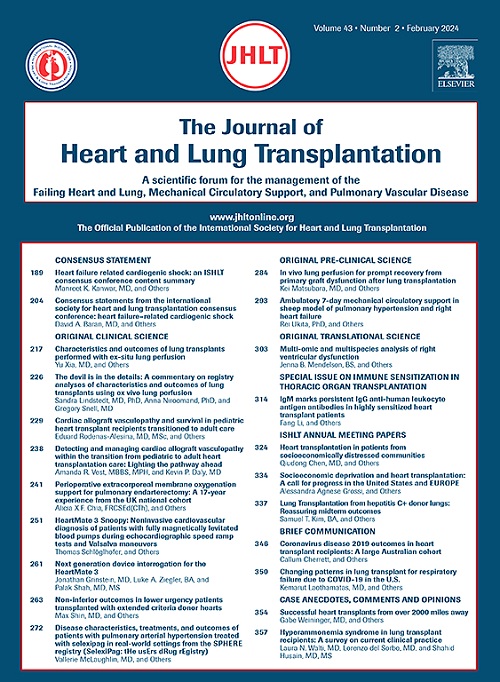缺失 Nr4a1 可改善循环死亡供体肺移植中的内皮细胞损伤和血管渗漏。
IF 6.4
1区 医学
Q1 CARDIAC & CARDIOVASCULAR SYSTEMS
引用次数: 0
摘要
背景:缺血再灌注损伤(IRI)是肺移植(LTx)中原发性移植物功能障碍(PGD)的主要诱因。特别是在心脏死亡(DCD)后捐献的肺移植中,有效控制温缺血(WIRI)后的IRI对预防PGD至关重要。本研究旨在确定影响心死后捐献的LTx中WIRI的关键因素:方法:对之前报道的肺WIRI的RNA测序数据集进行重新分析,确定核受体4亚家族A群成员1(NR4A1)为WIRI的直接早期基因。通过小鼠肺门钳夹模型验证了 NR4A1 的表达动态。为了研究NR4A1在WIRI中的作用,研究人员利用Nr4a1基因敲除(Nr4a1-/-)小鼠建立了DCD引起的LTx小鼠模型:结果:NR4A1位于血管细胞周围,在WIRI期间,其在肺部的蛋白水平迅速瞬时增加。与野生型供体相比,NR4a1-/-供体的LTx能显著改善肺移植功能(P < 0.001)。组织学分析表明,微血管内皮细胞死亡减少(P = 0.007),中性粒细胞浸润减少(P < 0.001),白蛋白渗漏减少(P < 0.001)。埃文斯蓝通透性测定显示,Nr4a1-/-供体移植物的肺微血管屏障完整性得以维持,这与肺水肿的减轻有关(P < 0.001)。然而,NR4A1对WIRI期间的炎症反应没有明显影响,将野生型供体肺移植给Nr4a1-/-受体时,IRI也未受到抑制:供体 NR4A1 在内皮细胞损伤和微血管高通透性的正向调节中发挥着特殊作用。这些研究结果表明,靶向 NR4A1 的干预措施有可能减轻 PGD 并改善 DCD LTx 的预后。本文章由计算机程序翻译,如有差异,请以英文原文为准。
Loss of Nr4a1 ameliorates endothelial cell injury and vascular leakage in lung transplantation from circulatory-death donor
Background
Ischemia-reperfusion injury (IRI) stands as a major trigger for primary graft dysfunction (PGD) in lung transplantation (LTx). Especially in LTx from donation after cardiac death (DCD), effective control of IRI following warm ischemia (WIRI) is crucial to prevent PGD. This study aimed to identify the key factors affecting WIRI in LTx from DCD.
Methods
Previously reported RNA-sequencing dataset of lung WIRI was reanalyzed to identify nuclear receptor subfamily 4 group A member 1 (NR4A1) as the immediate early gene for WIRI. Dynamics of NR4A1 expression were verified using a mouse hilar clamp model. To investigate the role of NR4A1 in WIRI, a mouse model of LTx from DCD was established using Nr4a1 knockout (Nr4a1−/−) mice.
Results
NR4A1 was located around vascular cells, and its protein levels in the lungs increased rapidly and transiently during WIRI. LTx from Nr4a1−/− donors significantly improved pulmonary graft function compared to wild-type donors. Histological analysis showed decreased microvascular endothelial cell death, neutrophil infiltration, and albumin leakage. Evans blue permeability assay demonstrated maintained pulmonary microvascular barrier integrity in grafts from Nr4a1−/− donors, correlating with diminished pulmonary edema. However, NR4A1 did not significantly affect the inflammatory response during WIRI, and IRI was not suppressed when a wild-type donor lung was transplanted into the Nr4a1−/− recipient.
Conclusions
Donor NR4A1 plays a specialized role in the positive regulation of endothelial cell injury and microvascular hyperpermeability. These findings demonstrate the potential of targeting NR4A1 interventions to alleviate PGD and improve outcomes in LTx from DCD.
求助全文
通过发布文献求助,成功后即可免费获取论文全文。
去求助
来源期刊
CiteScore
10.10
自引率
6.70%
发文量
1667
审稿时长
69 days
期刊介绍:
The Journal of Heart and Lung Transplantation, the official publication of the International Society for Heart and Lung Transplantation, brings readers essential scholarly and timely information in the field of cardio-pulmonary transplantation, mechanical and biological support of the failing heart, advanced lung disease (including pulmonary vascular disease) and cell replacement therapy. Importantly, the journal also serves as a medium of communication of pre-clinical sciences in all these rapidly expanding areas.

 求助内容:
求助内容: 应助结果提醒方式:
应助结果提醒方式:


